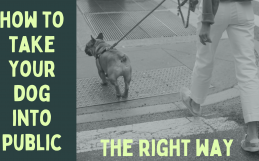Barking From The Window | Dog Training
How to Stop Your Dog from Lunging at Passerby’s
Start with the Basics
Are you the type of person that’s a bit of a control freak? Most dogs are actually like that too. If they feel like you’re not taking care of something the right way, they’ll jump in and handle it the way they think is best. Like barking incessantly at passersby as if to “protect” your home. This creates a lack of impulse control and your dog needs to be able to trust that you know when everything is going to be okay.
We have some easy steps to help you communicate and build that trusting relationship, so you can get your dog from where they are now, to a confident place where they will also trust your instincts.
Asking for Permission
Through this training, we want your dog to have a similar mindset as your children would. Kids know they aren’t allowed to go somewhere on their own without getting permission from their parents, right? We want your dog to communicate with you and “ask” for that permission as well.
Similarly, if somebody is walking by your house, your dog will likely look to you for a confirmation that things are okay. We want you to be able to communicate this by saying something like, “place” or “go lay down,” if things are okay. Or alternatively, giving them the permission to bark if someone approaching may look suspicious.
Impulse Control
Teaching impulse control is going to require you to take things slow in the beginning. If you start your training with teaching your end goal first, you won’t get the results you desire. It’s like teaching someone how to swim. If you start in the deep end, you’ll both drown.
Just like anything in life, when you train together, it should be fun and progressive. You should see victories and if you see failures or unsuccessful exercises, that’s okay too. It’s a learning experience.
You will always have your dog on a leash during these sessions (as with most training). You can remove the leash for potty breaks if you have a fenced yard or when you are not at home to ensure it doesn’t cause concern for injury or getting stuck on something. When you begin the training, have your leash in hand and be sure not to drop it. Don’t trust your dog in this moment because dropping the leash and breaking command will cause you to have to chase them down which could ruin the expectations of their behavior.
The Distraction Ladder
Think of a physical ladder. You have to start at the bottom to make your way to the top, right? The bottom of the ladder begins with the easiest thing you think your dog can succeed with and eventually working your way to the top towards the hardest thing. This could be something such as a “sit” command which begins that expectation of asking for permission. When they obey in the sit command, have them stay there for a few minutes, and begin to walk a circle around them.
Circling will create a challenge to some dogs who want to immediately move when you’re behind them and no longer in their line of sight. If they break command, guide them back to a sitting position and maybe use a little bit of pressure on the leash to guide their chest upwards and bottom to the floor. Once they’re back in “sit”, try walking your circle again.
Once you’re able to successfully complete this to where your dog nearly looks annoyed with you for how many times you’re walking around them in a circle (try not to get dizzy), you’ll turn and go the opposite direction. If they do not break command, then you will say “break” as a release command and praise them heavily. Their Love Language will come into play immensely here. Continue this method going in one direction for a bit, break and praise if they’ve held command, and then go the opposite direction.
Keep in mind this exercise should be done multiple times and may span over the course of a few days or throughout an entire day in small increments. You should spend about five to ten minutes max on these exercises at a time.
Moving on Up
To increase the intensity of this exercise, you’ll drop either toys or treats near your dog around the circle but not close enough to where they can get them from their sitting position. If your dog loves treats, start with toys. If your dog is a toy fanatic, start with treats. Something to catch their attention.
As you walk your circle now, you’re going to drop the toy or treat behind your back, while holding your dog’s leash, so they can hear it hit the ground. Be sure to keep it far enough away from them. Once your dog is not bolting to break their sit command, you’re then going to drop the treat or toy off to the side so it’s in front of them but next to you.
Keep Climbing
Once they’ve succeeded holding command with the above test and praise, you’re going to move on to dropping it directly in front of them. Make sure you’re about 2 feet away from your dog at this step. If you drop the treat or toy too close, they could easily snatch it out of thin air while still maintaining their sitting position. This would lead them to believe they can hold command and get what they want all at the same time. Have their cake and eat it too, if you will. 😉
The purpose of this exercise is to teach them to “ask” for and seek that permission from you to get the object instead of breaking on their own terms. If you see them break command after you’ve already dropped multiple treats or toys, tell them to sit again, pick everything back up and then start over. Once they successfully hold command, say “break” and they can go eat all the treats or play until the next session.
Note: Pay close attention to their body language during these exercises. Flinching doesn’t mean breaking command. If they flinch but stay rooted, be sure that follows with proper praise as it’s still a huge success.
Reaching the Top
You will keep the most difficult thing for your dog to accomplish at the “top” of the ladder. For most dogs, the hardest distraction for them to get through is being able to wait patiently at an open doorway. Getting to this level of success usually happens towards week 2 or 3. Remember, slow and steady wins the race.
You’ll want to break this down into every single step. Remember, your dog is on leash during this process, so hold on tight and remember to praise and reward.
- Step 1: Reach for the doorknob
- Don’t touch or open the door, this is just the motion of reaching for it. This will trigger your dog’s awareness. Continuously correct their bolting behavior and bring them back to a sitting position until they don’t care that you’re reaching for the door. Once they hold “sit” properly throughout this motion, move onto the next step.
- Step 2: Turn the doorknob
- Turn the knob, but don’t open the door. Jiggle it around, make noise, be distracting. Follow the same steps as above and wait for your dog to hold “sit” before moving on.
- Step 3: Crack the door open
- Begin to slightly to open the door while making sure your dog is being still. Flinching during these steps is okay, as long as they are not breaking their “sit” command.
- Step 4: Fully open and close the door
- At this step, you’ll want to open the door as wide as you can. Then close it. If your dog breaks command, guide them back and start over. Open and close the door a few times until you have a few successful sessions.
- Step 5: Take a step outside
- Step foot outside to your doorstep. Your dog should NOT follow you. If they do, guide them back to “sit” and try again. Say “break” after they have sat in position for a few still moments and they can come out to join you.
Time and Place
Place commands can be practiced for a far longer period of time than a basic “sit” command. The place command means to go and sit or lay on this object and stay there until you give your dog permission to do otherwise. See how well this fits the theme of this training? 🙂
Your dog can fall asleep and wake up still doing place, so it’s very beneficial to the overall livelihood of the home. They can sit, stand up, spin around, prance up and down, they just cannot step foot off that object.
Be sure that the object you choose to have your dog place on is comfortably big enough for them, but not too big nor too small. An item such as a cot or dog bed is great for this command. A spot on the tile floor or an area rug, however, would not be a good option.
So what now? You’re going to repeat every single step that you just did above, but utilizing the “place” command instead of “sit.” Remember, your dog will still be on a leash through all of this training, so you’ll be able to catch them if they try to bolt out the door.

Back to the Start
Now that you have built a trusting relationship with your dog and opened the communication barrier, they should be a little more attentive to where you are in the home. You can now have them “place” near the window (not directly under it, but maybe on the other side of the room) and await a passerby.
You can go into another room to wait this out. If they begin barking and lunging towards the window, verbally yell your “place” command from the other room and listen to see if the barking has stopped or if they’ve returned (or never left) their place object.
If they’re too caught up in the moment, barking and ignoring you, you can use some treats to lure them back to the place position. Throw the treats and when they come to you quietly, you can say “quiet” along with some affirmations like good boy/girl, etc. Eventually, they’ll begin associating the calm acceptable behavior with a reward. “Hey, I’m quiet, where’s my food?”
You can continue this process until you’re doing intermittent rewarding, meaning throwing treats only every other time or every two to three times this happens. Then once they’re successful inside of the house, you can move to the porch or in close proximity to the front of your home. Still keeping far away from the sidewalk. You can use the “place” or “sit” commands while outside, whatever you’re most comfortable with.
Recap
The key to a solid training foundation begins with relationship building. Much in common to our human relationships, bonds between dog and owner are best built with trust and communication. If you allow yourself to be patient, consistent, and understanding while working through these training steps, your success will gradually come. All dogs are different and some may pick this up right away, others may really have to work at it. If you find that you’ve exhausted all efforts and you still aren’t getting your end goal with these challenges or your dog is overly reactive and aggressive , be sure to consult a professional.
Still need help? – Post a comment
Leave a comment below if you need clarification on anything or if you have any other questions about your puppy.
Find “How To” Dog Training Videos HERE:








